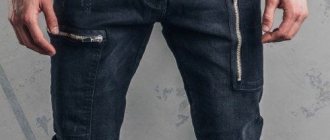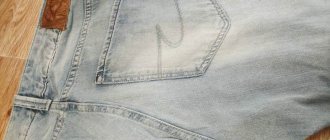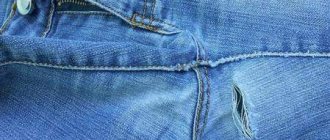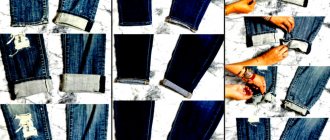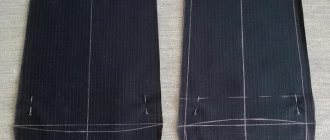Agree, it’s always extremely disappointing to notice that your favorite pair of jeans has begun to wear out in that very place
Agree, it’s always extremely disappointing to notice that your favorite pair of jeans has begun to wear out in that very spot. And it would be fine if the hole formed on the knee: you can just pretend to be the most fashionable, but the hole between the legs has never been in trend.
Don’t wait for this moment to come; it’s better to take care of the safety of your denim in advance. How? “Subtleties” tell.
Why do my jeans rub between my legs?
There are several reasons for the appearance of scuffs and holes in jeans between the legs:
- Body shapes. Excessive volume in the hip area, which appears due to heavy weight or increased muscle mass, leads to strong tension in the tissue during wear. In addition, with voluminous thighs, the gap between the inner thighs usually disappears, which leads to pant legs rubbing against each other along the entire length of the thigh.
- Way of walking. A gait in which the legs touch each other on the inside. In this case, the fabric can be rubbed both in the crotch and in the knees.
- Textile. The thicker the fabric, the less one is exposed to external loads. Artificial threads of elastane or polyester make the material stronger. While jeans made from thin denim will not have a long service life, especially if there are other reasons that contribute to the wear of the trousers.
The reasons for jeans rubbing between your legs can be different - from excess weight to poor fabric
- Sedentary work. Sitting still for hours is difficult, so the average person fidgets in his chair from time to time, shortening the life of his jeans.
- Errors when washing. Denim should not be washed in very hot water. Recommendations given by the manufacturer and on the label should be taken into account. If there is no such information, then the water temperature should not be higher than 45°C.
You also need to make sure that when drying, the pant legs are turned inside out and are not exposed to direct sunlight.
Expert opinion
Professional cutters blame the phenomenon of specific rubbing on the shortcomings of modern cutting. It turns out that denim wedges should be cut using a bias thread. Thus, when the legs move, they stretch slightly, providing freedom of movement. However, such a correct cutting method involves increasing the number of fabric scraps.
To reduce the cost of mass production, jeans wedges are cut in the thread direction, which is not subject to stretching. Therefore, constant load during movement leads to their premature damage.
Unfortunately, it is difficult for a non-professional to distinguish the correct cut from the incorrect one. The only reasonable solution would be to have jeans sewn to order from an experienced craftsman. In addition, many studios offer a long-term warranty on their products. So if your jeans, sewn in a studio, are frayed between your legs or anywhere else, you can quickly fix them for free.
Related Posts
leave a comment
What to do to prevent jeans from rubbing between your legs
In order for jeans to last a long time, even at the purchase stage you should be guided by certain selection rules:
- Tight models wear out faster. Therefore, it is better to opt for more spacious pants.
- Jeans with a high waist or a standard height are more wearable. This is due to their better fit to the body and uniform distribution of load on the fabric. Conversely, models with a low waist will rub in the crotch faster.
- For sedentary work, it is recommended to choose thick denim trousers. And also knowing about the problem of abrasion, you should control your own movements as much as possible. For example, do not “ride” your heel on the chair, but stand up if you need to reach something or bend over.
- It is advisable not to let jeans appear until holes appear. As soon as abrasions and thinning of the fabric become noticeable, measures should be taken immediately - strengthen the fabric.
Step 1: What you will need
- A pair of damaged jeans
- Another pair of unwanted old jeans or a scrap of material from them
- Needle
- Polyester thread of the required color
- Pins
- Scissors
If you're frugal enough, you probably have an unwanted pair of jeans in the right color in your closet. I'm not so perspicacious and always threw them away, I won't do that again!
You can definitely do a better job than me if you can find a pair of repair jeans in the same color. As you can see in the photo, my color is slightly different.
It is highly advisable to use a thread made of polyester; it stretches very well, while a thread made of 100% cotton will most likely not withstand the load. You can easily find them on sale here at reasonable prices; in extreme cases, you can order them from China.
How to repair jeans by hand
To repair jeans, you don’t have to be an experienced seamstress; it’s enough to be able to hold a thread and a needle and use it to make simple seams.
What you need for work
The threads you choose for sewing on denim must have high strength.
Threads from the following manufacturers have proven themselves well:
| Firm | Threads |
| Haman | Saba 50, Saba 35, Saba 30, Rasant 75 |
| Gutermann | H120, H75, H35 |
| Coats | Epic 60, T-80N, T-60 |
| Rain Bow | A 202/120 |
If these items are not available in the store, then the choice should be made in favor of reels with an inscription indicating increased strength. If the threads are cotton, numbers 50-80 are suitable. Synthetic threads – 50-60.
To repair jeans, you should use needles with numbers 11 or 14 and a sharp end. If you do not plan to make a decorative patch, then you need to use denim fabric of the most identical color or any other fabric that matches the shade. Additionally, you will need scissors and pins.
Patch
To make a classic patch, you will need 2 scraps of fabric. The first one will be used as a lining, so it can be any color. The second one, if possible, should be matched to the tone of the jeans, then the patch will be less noticeable. However, it is impossible to completely disguise a patch, so patches are often made, on the contrary, more noticeable.
Stages of work:
- Patches should be cut from both pieces of fabric, the size of which should well cover the area of damage and leave 1 cm for the hem.
It is not necessary to fold the bottom flap if the fabric is not loose. Also, if the selected piece of fabric is very dense, then the hem will add unnecessary volume, which can sometimes even rub the body when worn.
- It is recommended to machine stitch the bottom patch. To do this, the flap should be pinned to the pants, then sewn around the perimeter using a machine. Next, you need to lay stitches in different directions inside this perimeter to better attach the fabric to the jeans.
- You need to fold the edges of the outer patch so that the remaining fabric covers the hole and iron it. Then attach the patch to the jeans using thread or pins.
- You can sew on a patch using any seam, from a hidden seam to hide the threads, to a looped one, which, on the contrary, will make the processed edge more visible.
General sewing tips
If the problem of holes and abrasions in jeans between the legs is constant, then it is recommended to strengthen this area of the pants immediately after purchasing the product and washing it for the first time.
Also, you should not wait until the abrasion turns into a hole or a small hole becomes a big one. Taking preventive measures will increase the service life of jeans.
You should carefully consider the choice of fabric for the lining. For example, thick material or thick denim can subsequently chafe the body, especially if the jeans model is narrow. To make the repair of trousers less noticeable to others, you should take the time to find sewing threads that match the color of the fabric.
Sewing the edges
When the hole is small, has a longitudinal shape and does not have torn edges, it can be sewn up with an “over the edge” seam.
For greater strength, it is recommended to first sew the seam “forward with the needle” along the edge.
Strengthening the hole
Sometimes the hole does not need to be sewn up, but strengthened. Jeans that initially have rips and holes can, over time, increase in size and turn into holes, and the holes can become shaggy and untidy.
To prevent further unraveling of the fabric, as well as to update the jeans, you need to make a patch on the wrong side. To do this, you need to take material from old jeans and make two horizontal cuts, the size of which will correspond to the hole being repaired. Then you need to carefully pull out the vertical threads.
After the desired size is reached, this patch should be cut out, retreating 1 cm from the sides. At the final stage, the cut out patch must be sewn on, placing it on the inside under the hole. Sew on with small stitches using thread to match the denim fabric. You can also sew a lining patch in a contrasting color along the edge of the hole.
Problem solving methods: manual, “machine”
The simplest ways to extend the “life” of your favorite item for several months are to apply a patch on the inside of the product, and on the outside - forming the thickest stitch possible, which will imitate the thread-like weave of the fabric.
Manual method No. 1
What you will need for implementation:
- soft fabric, which will play the role of the patch itself (it should not be loose - dublerin with glue and fabric base is suitable);
- strong thread for sewing;
- scissors, needle, chalk.
Repair process:
- Wash, dry the product, iron it so that there are no wrinkles in the upper part.
- Turn your jeans inside out.
- If there is already a hole in the problem area, sew it up by hand.
- From the fabric for the patch, form a piece of suitable size. It should completely cover the abrasion. Add 1.5 cm on all sides.
- Secure the patch using an iron or basting.
- Turn the garment right side out and use your hands to form stitches parallel to the denim.
- Try to place them as close to each other as possible.
- Once one side is “done,” turn the fabric over and continue sewing until the entire damaged part is covered.
- Do all of the above with the other pant leg.
Manual method No. 2
Involves sewing on a denim insert of a similar color. What is necessary:
- a piece of denim;
- two threads: 1) to match the color of the jeans, 2) to match the seam on the pants.
- Needle, scissors, ruler, chalk, iron with steam generator;
- Paper and pen.
Implementation:
- Wash the product and patch, iron thoroughly.
- Using nail scissors, cut all the seams down to the middle.
- Make a mark with a bar of soap or chalk - you need to understand which part needs to be cut off (the damaged area should be behind this line).
- Take a ruler and draw straight, parallel lines on the two legs. For a seam allowance, you need to draw a second line - 1.5 cm further.
- Cut the fabric along the first lines; if it turns out uneven, correct it.
- Attach the resulting pieces of fabric to a sheet of paper, trace with a pencil, cut off the necessary flaps - make a pattern for the insert.
- In the place where the flap will be sewn to the pants, leave 1.5 cm for the seam.
- Apply the resulting pattern to the denim, outline it with chalk, and cut it off.
- For a parallel leg, make a mirrored piece of fabric.
- Baste the tabs to the jeans as evenly as possible, then sew them up with blue thread. The seams are in the same color as the factory one.
If it was not possible to beautifully restore the product, then, alas, after all these manipulations it will have to be sent to the trash heap. Therefore, before you start, you should think carefully and evaluate your capabilities.
How to sew up a hole between your legs using a sewing machine
If you have a sewing machine, you will have to work a little more seriously, as you will need additional knowledge and sewing experience. If there are any, then even a trace of the problem will not be noticeable on your jeans with a fray or a hole.
What should be done:
- Pull the fabric as tightly as possible so that there are no seams. This is the main rule to follow when sewing a stitch.
- The seam should be vertical so that it matches the structure of the denim as much as possible. This way you can “veil” the hole as unnoticeably as possible.
- The patch is basted only with a zigzag.
- If you don’t have a thread on hand to match the color of your jeans, you can take two similar colors and combine them - in the game it will be lighter, in the bobbin it will be darker.
- The resulting hole must be masked using the “stuffing” method.
https://youtube.com/watch?v=l_clbeXb3Sc
Conclusion
Which method to choose is up to you. But, do not forget to remember your abilities regarding sewing skills. All seams should be as beautiful and even and neat as possible. Otherwise, you will have to say goodbye to your favorite thing forever.
Darning on a sewing machine
It is usually easier to mend jeans between the legs using a machine than by hand.
Such repairs will also be more durable:
- To repair jeans, you need to properly prepare the area for the patch. It is necessary to cut off all protruding threads. You also need to trim the edges of the hole so that the outline is clearly visible. This will ensure that important areas are not missed when performing the patch.
How to mend jeans between legs using a sewing machine
- Then you need to cut out a piece of denim that matches the color and preferably the thickness. The part should be 1 cm wider than the hole.
- The patch should be secured on the wrong side with pins and sewn on with a few stitches on a machine. It is not recommended to baste the patch by hand, as it will be extremely difficult to remove the basting threads after darning.
- You should darn from the front side, placing the seams as close to each other as possible. Ideal if you can repeat the direction of the denim threads.
- Next, you need to fill the surface with stitches running in a perpendicular direction.
Repairing jeans when they are frayed between the legs
This short video shows an easy way to repair jeans that have, for obvious reasons, worn out between the legs. The most important thing in this matter is to prevent the hole from getting bigger! Otherwise, it will be more difficult to mend it later.
First, you need to prepare cushioning and adhesive materials: adhesive web, non-woven serpyanka - fabric with an adhesive composition applied to it.
Let's cut out pieces that are suitable in size for the frayed web, serpyanka and non-woven fabric. Let's place a sandwich of these materials sequentially on the wiped area, first the serpyanka, then the cobweb, then the interlining from the inside of the jeans in the area between the legs.
Then we press the sandwich to the jeans with a hot iron and add steam - if the iron is steam. If not, then any other will do. The main thing is that everything sticks.
There is practically nothing noticeable on the front side of the jeans.
We begin an important step in the repair - selection of threads. It's difficult to choose the right thread based on color
Especially if there is a large selection. The bobbin also needs to be wound with matching threads. It is advisable to mark the boundaries of the darning - this makes it easier to control the area of work. And under the needle. 1.7 is the stitch length - it should be small.
You need to stitch along the keeper - this is the direction of the weave of the threads in the fabric. The keeper is determined as follows - from bottom to top, from left to right. On this fabric it was necessary to stitch in stripes - the denim material turned out to have stripes and this only became apparent after numerous lines.
When repairing worn areas, try to place stitches at a distance of 0.5 mm from each other and do not rush - enjoy the process! We check the work done. It was decided to stitch again in places where there were gaps between the lines. View after the repair from the inside, view from the front side of the fabric depending on the lighting. In some photos, in the place of wear between the legs, the color of the thread matches the color of the fabric, in others it does not.
How to install a patch
There are two ways to mend jeans between your legs using a machine.
Classic version
It is easy to close a hole or abrasion by making a regular fabric patch over the damage. The square patch is quick and easy to sew on, which is why it is the most popular.
To make a square patch, you need to cut out a square from the fabric that will cover the hole, leaving 0.5-1 cm for the hem. Then the part should be ironed, bending the edges and secured to the jeans. Experienced craftswomen can use pins for this.
For those who are not confident in using a sewing machine, it is better to baste the patch by hand. Next, the square must be sewn to the jeans, placing the seams around the perimeter of the workpiece.
This method can be difficult if the hole is in a hard-to-reach place. In this case, you can simplify the work if you slightly open the nearest factory seam. After the hole is sewn up, all that remains is to carefully stitch the seam, choosing threads of the desired color.
Recovery
It is possible to mend jeans between the legs using a machine even when the damage is large and the patch option is no longer suitable. To do this, you should use the restoration method, which consists of completely replacing the damaged part of the product. In this case, the replacement should be made symmetrically.
To work you will need:
- pieces of denim of a suitable color,
- threads of 2 colors: to match the jeans and matching the threads used to make the seams on the jeans by the manufacturer.
Stages of work:
- It is necessary to rip out part of the back seam running in the center, as well as the side seams.
- Cut out the frayed section of the pants.
- Next, on the other side of the back seam, cut a piece of fabric identical in shape.
- The cut piece of jeans should be attached to the prepared flaps and symmetrical parts should be cut out.
- Then all the details need to be basted and carefully sewn into the jeans.
To prevent the jeans at the crotch from fraying longer, it is recommended to cut the insert parts so that the guide threads run diagonally. This will allow the fabric to stretch better.
You can also strengthen your jeans if you use thick corduroy or leather rather than denim. To make the insert look natural, you can sew patches from the same fabric in other places on the jeans.
At the initial appearance of abrasion
Holes do not appear immediately. Having noticed that the material has become thinner, it is necessary to strengthen it. Don't expect a through hole! Take the pants to a repair shop or do the repairs yourself.
On the wrong side it is necessary to apply a denim patch. The easiest way to secure it is with adhesive tape - “spider web”. Instead, you can use special fabric glue.
@Zen.yandex.ua
Pay attention to washing your pants. It should be gentle, without using aggressive means.
Avoid machine drying
It speeds up the process, but does not have the best effect on the safety of denim.
We hope that with these simple tips you will be able to extend the life of your jeans.
How to sew up a hole in jeans without a patch
You can mend jeans between your legs either with a machine or with your hands. It all depends on the type of damage and its location.
For example, in some cases there is no need to sew a patch onto the damaged area of the jeans. If the hole is a straight line, or resembles the letter “G”, then it is recommended to darn it manually without using patches.
What you will need:
- A needle of medium length or long.
- Threads matched as closely as possible to the tone of the denim fabric.
Stages of work:
- It is necessary to stitch along the long side of the abrasion. If “native” threads of the fabric remain on the damage, then the thread should be passed alternately under such a thread, then over the next thread.
At the end of the row, the needle should be threaded from the edge through 2-3 threads of the undamaged part of the fabric. When turning to the next edge, you need to maintain a balance - the distance from the edge of the hole should be minimal, but at the same time ensuring good fastening. This will make the darned area less noticeable and will also prevent the fabric from fraying further.
- The threads should be pulled as close to each other as possible. The density of the darning and its durability depend on this.
- Next you need to continue darning along the short side of the hole. The needle should also be passed first under the thread located perpendicularly, then over the next thread. It is important to ensure that the fabric is dense, without gaps.
- With a successful selection of thread color and proper darning, the repaired area will be barely noticeable.
Method without a machine
If a hole has formed along the seam or the seam itself has burst, then it is worth meticulously assessing the condition of the fabric. Thin textiles are easier to throw away and forget. But the material is still quite dense, use a popular life hack with a hidden seam:
- Place parallel stitches across the hole, from bottom to top (or vice versa). It will look like sleepers or bridges across the gap.
- Stitch into the seam and tighten.
To make sure everything works perfectly, follow these tips:
- do not cling to the very edge, step back 2-3 mm;
- To prevent the edge from fraying (important for stretch and cheap jeans), duplicate it with a “spider web” - it is inexpensive and is sold in any sewing store.
The advantage of this method is that it is fast, easy, and you don’t even need to match the threads. But the disadvantage is the reduction in size. The unraveling seam will be sewn up without damage. But a hole in a solid piece of fabric will tighten it a little. You can’t sew up rectangular and round holes like that. But if the tear is like a gap, then a hidden seam is the best way to quietly and manually patch the hole.
Other repair methods
A hole in your jeans is not always a reason to be upset.
If you approach the problem creatively, you can create interesting and fashionable things.
How to hide a hole in jeans, fill it up beautifully, decorate it
There can be many options when the hole is not just sewn up, but also decorated.
How to sew a hole in jeans between the legs
Mending jeans between the legs using a machine may seem like a boring solution to the problem for some. Especially when modern fashion welcomes street style.
To take advantage of the opportunity and add a “zest” to your favorite pants, you can choose a deliberately bright thread for darning or, using traditional darning, perform sashiko stitches or any other embroidery.
How to fix a hole in your knee
You can decorate a torn knee using the Japanese technique of sashiko. Sashiko embroidery consists of simple forward stitches made with contrasting thread that can be worked in any direction.
Stages of work:
- You need to cut a rectangular piece from the desired fabric. This part should be 3 cm larger than the hole.
- Having placed the patch on the inside, you need to baste it. Since the hole is on the knee, the fabric of the patch should not be stretched, otherwise the knee will be difficult to bend.
- To ensure that the rows of sashiko stitches run smoothly, it is recommended to draw the lines with chalk, a piece of soap or a special washable felt-tip pen.
- Stitches should be short on the front and long on the back. In this case, a number of stitches must be made with a needle at once, collecting the fabric into an accordion.
- How many rows to make depends on the imagination of the craftswoman. The main thing is that there are enough of them to secure the patch on the knee.
How to remove a hole in your butt
Holes do not always need to be darned or sewn up using classical methods.
Damage to pants on the butt, hidden behind bright appliqués or embroidery, often looks more interesting and natural.
How to remove a hole in a pocket
Jeans pockets often get worn out. Rear due to friction against outer clothing or chairs. Holes may appear on the front ones when there is a habit of keeping your hands in your pockets or carrying small things in them.
Jeans will look fashionable if you don’t hide the hole, but rather emphasize it. The only thing to keep it from spreading is to secure the edges.
The hole can be given any shape, for example, made in the shape of a heart. Small wear on the pocket can be hidden behind embroidery done with simple stitches. Embroidery and appliqués allow your imagination to unfold as much as possible.
There are many ways to sew jeans between your legs. For some it is easier to do this on a machine, for others it is better to sew by hand. If you have no sewing skills at all, you can glue an applique.
Author: Vorobyova Nadezhda
Article design: Natalie Podolskaya
Methods for repairing trousers between the legs
So, how do you fix pants that are frayed between your legs? There are two main ways to restore your pants to their original appearance. Each of them is described in detail below.
Mend pants by hand
This method is suitable for small abrasions on denim. This will require threads similar in thickness to the fibers of denim material. Also, the threads must be the same color and shade, otherwise the place in which they are sewn will be obvious.
Secure the seam to an undamaged area of the fabric and use small stitches to pass the thread over the worn area. Then the fabric will not warp. After this, make stitches across, passing the needle between the threads. It should look like weaving new fabric to replace worn-out fabric. The better the threads are selected and the tighter the seam, the less noticeable and durable the result will be.
How to make a patch on pants between the legs?
Repairing trousers using a patch, which is placed on the wrong side, is called “stuffing”. This will require a special patch fabric. It comes in two types: one can be ironed to the trousers, the other will have to be sewn on by hand. If the hole in the pants is small, then any color material will do. Otherwise, you will have to choose a color to match the trousers. You will also need, as in the previous case, plain threads.
Step-by-step instructions for installing the patch:
Start by turning your jeans inside out and looking for a rip or hole. Cut a piece of patch material so that it is slightly larger than the worn area. If the fabric is pressed with an iron, then, having set the required temperature and turned on the steam treatment, carefully place the patch from the inside of the trousers
Attention! After gluing the patch, there should be no folds in this place. To do this, pre-wash your trousers and mend them while they are slightly damp. If we are talking about a small hole in jeans, then on the front side, on top of the patch, you can mend it with plain threads (as in the first method)
In this case, the patch will help the seam last much longer. For repairing pants made from another type of fabric, darning will not help. The inconspicuousness of the patch will be affected only by the correctly selected shade of material and thread.
Algorithm for creating neat holes
To create stylish holes with fringe, in addition to the jeans themselves, you need to prepare the materials at hand:
- thick cardboard or plywood;
- sharp stationery knife or scissors;
- chalk, bar of soap or pen;
- sewing ripper or needle;
- a piece of sandpaper, pumice, a finely notched grater, a file or brush;
- tweezers, awl.
First, jeans are put on and the location of future holes is estimated. The upper and lower boundaries of the future slot are marked with chalk; the lines should be parallel to each other. Now you can start fashion design:
- Plywood is placed inside the trouser leg so as not to damage the fabric on the other side.
- Make a couple of neat cuts parallel to the white threads, following the marked lines. When cutting fabric, you need to be careful not to damage the white fibers.
- White horizontal threads are pulled out with tweezers, and transverse colored threads are pulled out. Only a white grid should remain in the selected area.
- To get a disheveled look, sand the edges of the hole with fine sandpaper or use an awl. You can moisten the fabric along the edge of the hole, roll it up and secure it with pins, and let it dry.
- To record the result, the jeans are immediately washed in an automatic machine.
In this way, both women's and men's jeans are transformed. To give the slits a careless look, some of the white threads can be torn and stretched. The edges of the hole are reinforced with a seam or glued with non-woven fabric on the wrong side of the fabric. For men's jeans, the edges of the holes should be made rougher.
Video on how to make ripped jeans
https://youtube.com/watch?v=5HFz6XBrB7Q%C2%BB%26gt%3B
Bottom line
Jeans are incredibly comfortable and practical clothing, but often the natural fabric wears out in delicate places, requiring urgent repairs. There are several ways to patch your favorite pair:
- put the patch on, “planting” it from the inside out onto the doublerin;
- install a temporary adhesive patch;
- stitch the frayed areas using a machine, creating a reliable darning from threads that match the tone;
- take your favorite jeans to the tailor.
If the problem of denim abrasion between your legs is familiar to you, then remember the rules of prevention and try to put them into practice.
By following a simple technique, you can significantly extend the life of your jeans without repairs. When using materials from thebestvideo.ru, a link to the source is required.
How to prevent the problem
For those who constantly have to deal with jeans that are worn out between their legs, it is useful to remember a few simple rules for preventing the problem.
Choosing the right size
Choosing the right size is the first step in increasing the durability of your jeans. To prevent jeans from fraying, you should not buy tight products. Excessive tension of the fabric, if you want to fit into a smaller size than necessary, provokes wear. With a large size, the folds from excess material rub against each other.
Normal or high fit
Models with a high or normal fit fit the body better, sit naturally, and form fewer creases in the groin area. Experience shows that with a low waist, jeans rub faster.
Proper washing
Jeans should be washed in the recommended washing machine mode, without exceeding the temperature, without excess detergents and chemical stain removers, with the zippers turned inside out and zipped up. Do not fill the drum with several products at once - they will damage each other.
If your jeans are already torn, it is better to wash them in a special bag.

